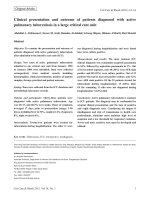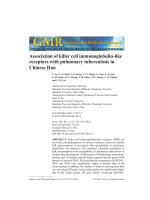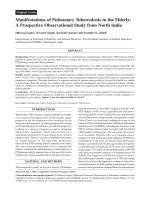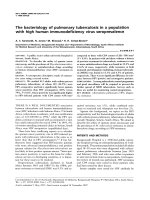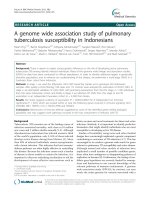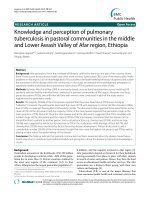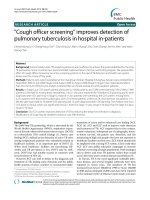Diagnostic and Therapeutic Problems of Pulmonary Tuberculosis in Elderly Patients doc
Bạn đang xem bản rút gọn của tài liệu. Xem và tải ngay bản đầy đủ của tài liệu tại đây (91.09 KB, 6 trang )
INTRODUCTION
Although the prevalence of active pulmonary tuberculosis
(TB) among Koreans above 5 yr old decreased gradually from
5.1% (1,240,000 cases) in 1965 to 1.0% (429,000 cases) in
1995, there are still many TB patients in Korea (1, 2). Even
in developed countries where the overall incidence of TB is
low, pulmonary TB remains common among the elderly (3).
Increases in the elderly population due to prolonged life ex-
pectancy have increased the use of drugs that suppress cellular
immunity, and may further increase the incidence of pulmo-
nary TB among the elderly in the future (4). Many studies
have been performed on the pulmonary TB in the elderly
(5-19). Some have suggested that pulmonary TB in the elderly
presents somewhat atypical symptoms (6, 7) or radiological
findings (8-10) or both (11), or that the elderly are more sus-
ceptible to adverse drug reactions (12, 13) and more likely
to die of the disease (6, 14). Age-related changes in the tuber-
culin skin reaction and a high incidence of underlying illnesses
also play a role in prolonging the final diagnosis (15). Some
have even suggested that pulmonary TB in the elderly should
be classified as a separate entity (16).
However, many studies (17-19) have reported that TB in
the young and elderly shows similar clinical, bacteriological,
and radiological features. Pulmonary TB is still one of the
most prevalent diseases in Korea, and accordingly most physi-
cians and radiologists are familiar with TB, and suspect the
presence of TB in cases with undiagnosed pulmonary disease.
Studies in this special situation would help our understand-
ing of the characteristic clinical features of elderly pulmonary
TB in areas where TB prevalence is intermediate. We previ-
ously performed a retrospective study to elucidate differences
in the clinical, microbiological, and radiological features of
TB in the young and elderly (20), and the result concurred
with other studies as it suggested that the elderly have atypi-
cal clinical and radiologic characteristics. However, the study
population was relatively small, and some of the radiological
interpretations were not made by an experienced chest radi-
ologist. Thus to confirm our previous study results, the pre-
sent study was designed to incorporate a larger study popu-
lation and to incorporate more consistent radiologic inter-
pretation by experienced chest radiologists.
MATERIALS AND METHODS
Study population
Medical records and chest radiographs of active pulmonary
TB patients, who visited the Seoul National University Bora-
Jae Ho Lee, Dae Hee Han
*
,
Jae Woo Song
, Hee Soon Chung
Division of Respiratory and Critical Care Medicine,
Department of Internal Medicine; Department of
Radiology
*
, Seoul National University College of
Medicine, Seoul; Department of Radiology
, Asan
Medical Center, University of Ulsan College of Medicine,
Seoul, Korea
Address for correspondence
Jae Ho Lee, M.D.
Division of Respiratory and Critical Care Medicine,
Department of Internal Medicine, Seoul National
University Bundang Hospital, 300 Gumi-dong,
Bundang-gu, Seongnam 463-707, Korea
Tel : +82.31-787-7011, Fax : +82.31-787-4052
E-mail :
*This study was supported by a grant from the Seoul
National University Bundang Hospital.
784
J Korean Med Sci 2005; 20: 784-9
ISSN 1011-8934
Copyright
�
The Korean Academy
of Medical Sciences
Diagnostic and Therapeutic Problems of Pulmonary Tuberculosis in
Elderly Patients
To identify differences in the clinical, radiologic, and microbiologic features of pul-
monary tuberculosis (TB) in the young (<64 yr) and elderly (
≥
65 yr), we performed
a retrospective analysis of the medical charts and chest radiographs of 207 young
and 119 elderly pulmonary TB patients. Hemoptysis and a febrile sense were
more frequent in the young, whereas weakness, dyspnea, anorexia, and mental
change were more frequent in the elderly. Elderly patients showed higher frequen-
cies of cardiovascular and chronic lung diseases, whereas the young showed a
higher proportion of underlying liver disease. In addition, chest radiography showed
a significantly higher frequency of mid or lower lung involvement by TB lesions in
the elderly (10.6% vs. 22.7%, p<0.05). Lesions were frequently misdiagnosed as
pneumonia or lung cancer in the elderly. However, there was no difference between
these two groups in terms of sputum acid-fast bacilli positivity. The elderly showed
a higher frequency of adverse drug reactions (18.5% vs. 40.7%, p<0.05), and
higher TB-related mortality (1.3% vs. 11.1%, p<0.05). In conclusion this study
showed that young and elderly pulmonary TB patients have similar microbiologic
features; however, the elderly showed higher frequencies of atypical clinical and
radiologic presentations, adverse drug reactions, and higher TB-related mortality.
Key Words : Aged; Tuberculosis; Symptom; Radiography; Microbiology; Diagnosis, Differential; Drug Reac-
tion; Prognosis; Sputum
Received : 11 February 2005
Accepted : 19 Arpil 2005
Pulmonary Tuberculosis in the Elderly
785
mae Hospital during the period January 1994 to December
2000, were reviewed. We included only pulmonary TB cases
and excluded all other forms of TB, like hilar and/or medi-
astinal lymphadenopathy, TB pleurisy, and miliary TB to
allow better data comparisons. Cases of pulmonary TB with
coexistent extrapulmonary TB were also excluded from the
study population. During the study period, 428 cases of active
pulmonary TB were treated using anti-TB medication. Thir-
ty-five relapsed cases, 20 multi-drug resistant TB cases, and
47 cases already diagnosed as TB at other hospital were also
excluded. Finally 326 patients that satisfied the above crite-
ria were eligible for analysis. For comparison purposes, the
326 pulmonary TB patients were divided into two groups:
patients aged less than 65 yr (the young patients) and those
aged 65 yr or more (the elderly patients). All patients were
human immunodeficiency virus (HIV) negative.
Diagnosis of active pulmonary tuberculosis
Sputum acid-fast bacilli (AFB) smear/cultures were per-
formed at least three times. Bronchoscopy and washing for
AFB detection was performed only in selected patients; only
14 young and 15 elderly underwent bronchoscopy procedure.
Active pulmonary TB was diagnosed in the presence of at
least one of the following criteria; 1) a positive sputum or
bronchial washing fluid AFB smear and/or positive culture
for M. tuberculosis regardless of sputum or bronchial wash-
ing fluid smear results; 2) biopsy-based histologic confirma-
tion of the lung lesion; 3) chest radiographic findings com-
patible with TB and a favorable response to treatment in cases
without bacteriologic or histologic confirmation.
Data collection
Collected data included the following: demographic charac-
teristics, presenting symptoms and body temperature, under-
lying illnesses, laboratory findings (including microbiologic
study at the time of diagnosis), radiological features, adverse
reaction to anti-TB drugs, and mortality during treatment.
Initial presenting symptoms about which patients complained,
and highest body temperature measured during initial pre-
sentation were included. A body axillary temperature above
37.5
℃
was defined as elevated. The location, lesion appear-
ance on initial chest radiographs, and first clinical diagnoses
were recorded. TB lesion locations were categorized as upper
lobe involvement (upper alone or upper with middle or lower)
and isolated middle or lower lobe involvement. The radio-
logic appearances of TB lesions were classified as typical fibrous
nodular and/or a cavitary lesion, a pneumonia-like lesion, a
mass-like lesion, or as others. This radiologic classification
was made according to interpretation of initial radiographs
taken when patients first visited hospital before a definite
diagnosis had been made. First clinical diagnoses were clas-
sified as TB, bacterial pneumonia, lung cancer, and others.
After a diagnosis of active pulmonary TB had been made and
medication started, all patients were seen one week after medi-
cation start by a physician and monthly thereafter, and at these
visits were questioned about drug side effects. Liver function
tests were checked after one week of medication, and were
monitored by complete blood count (CBC) and simple chest
radiography monthly thereafter.
Anti-tuberculosis medication
Patients were treated initially using the following daily
regimen: isoniazid 400 mg (300 mg for patients with a body
weight <50 kg), rifampicin 600 mg (450 mg for patients
with a body weight <50 kg ), ethambutol 800mg (600 mg
for those with a body weight <50 kg), pyrazinamide 1,500
mg (1,000 mg for those with a body weight <50 kg). Pyrazi-
namide was medicated through the entire treatment period
if patients were tolerable and no adverse reaction occurred.
In patients with underlying liver disease, e.g., liver cirrhosis
or active hepatitis, pyrazinamide was not prescribed from the
medication regimen from the start. Non-hepatotoxic drugs
like cycloserine or quinolones were prescribed in patients with
significant hepatotoxicity (serum transaminase >3 times the
normal upper limit). But as soon as liver function recovered
or stabilized, drug therapy regimens were cautiously changed
to regimens that included isoniazid and rifampin. Treatment
duration was at least 6 months.
Adverse drug reactions
Drug adverse reactions were defined as; 1) side effects that
caused medication discontinuance or change (either tempo-
rally or permanently) and/or that directly resulted in hospi-
talization; or 2) when some other symptomatic treatment was
necessary to relieve symptoms. Drug induced hepatitis by
anti-TB medication was defined as; 1) a transaminase increase
to >3 times the normal upper limit; and 2) any elevation of
transaminase above basal levels in the presence of icteric hep-
atitis. If drug induced hepatitis was suspected then isoniazid,
rifampicin, and pyrazinamide were stopped, but when liver
function returned to normal the drugs were sequentially rein-
troduced. Pyrazinamide was not reintroduced. Mild side effects
tolerated by patients, or transient mild leucopenia (>3,000/ L)
were not considered major drug side effects. Prognosis dur-
ing treatment was evaluated by mortality during treatment.
Statistics
Statistical analysis was performed using the SPSS Version
11.0 software package. Statistical differences between the clini-
cal features of the two groups were determined with chi-square
test and Yates correction except when expected values of less
than 5 required the use of the Fisher exact test. The Student’s
t test was used when indicated for independent means.
786
J.H. Lee, D.H. Han, J.W. Song, et al.
RESULTS
Demographics
Three hundred twenty six patients who satisfied the above-
mentioned inclusion criteria comprised the study population.
Of these patients, 27 were transferred to other hospital after
an initial diagnostic workup, and 67 dropped out during fol-
low-up. There was no difference between the two groups in
terms of transfer rate to other hospital or follow-up loss. Final-
ly 232 patients completed their anti-TB medication, adminis-
tered over a minimum of 6 months at our hospital, thus drug
adverse reactions and prognosis were analyzed using their
data. The clinical characteristics, initial diagnosis, and diag-
nostic criteria of pulmonary TB for the 326 subjects are shown
in Table 1. Two hundred seven patients were allocated to the
young age group and 119 to the elderly group. The mean
ages of the young and elderly patients were 40.5 yr (range,
16-64 yr) and 74.8 yr (range, 65-85 yr). The young group
showed a significant male predominance (p<0.001), and an
initial diagnosis of active pulmonary TB was made correctly
in 94.2% in the young group but in only 66.4% in the elder-
ly group (p<0.001). Twenty-five of the 119 elderly groups
were misdiagnosed as having bacterial pneumonia compared
to 9 of the 207 young groups. Fourteen elderly patients but
only 3 young patients were considered to have lung cancer
initially. The diagnostic criteria of active pulmonary TB are
presented in Table 1. No significant difference was observed
between the two groups in terms of positive sputum AFB
culture.
Presenting symptoms
The proportions of patients with different symptoms are
compared in Table 2. The data shown represent all cases. Cough
was the most frequent symptom in both the young and elder-
ly groups, without significance. However, hemoptysis was
more frequent in the young, and dyspnea more frequent in
the elderly. Nonspecific general symptoms like weakness,
weight loss, anorexia, and mental change were more frequent
in the elderly. Though a febrile sense was more frequent in
the young, no significant difference was found between the
two groups in terms of body temperature elevation. Fifteen
of the 207 young patients were asymptomatic and present-
ed only a chest radiographic abnormality compared to 2 of
the 119 elderly (p=0.037). Symptom duration was signifi-
cantly greater in the elderly.
*: Standard deviation.
p value
Elderly (≥65 yr, %)
(n=119)
Young (<65 yr, %)
(n=207)
Age (mean
±
SD*, yr) 40.5
±
14.8 74.8
±
6.2
Gender 0.001
Male 143 (69.1) 61 (51.3)
Female 64 (30.9) 58 (48.7)
Initial Admission Diagnosis
Tuberculosis 195 (94.2) 79 (66.4) <0.001
Pneumonia 9 (4.3) 25 (21.0)
Lung cancer 3 (1.4) 14 (11.8)
Others 0 (0) 1 (0.8)
Diagnostic Criteria of Tuberculosis
Sputum AFB culture (+) 154 (74.4) 84 (70.6) 0.679
Bronchial Washing Fluid 8 (3.9) 7 (5.9)
AFB culture (+)
Sputum AFB smear 6 (2.9) 6 (5.0)
(+) only
Histology 18 (8.7) 9 (7.6)
Radiology and Clinical 21 (10.1) 13 (10.9)
feature only
Table 1. Population characteristics of the young and the elderly
pulmonary tuberculosis patients
The data shown are for all cases.
p value
Elderly (≥65 yr, %)
(n=119)
Young (<65 yr, %)
(n=207)
Respiratory symptoms
Cough and/or sputum 157 (75.8) 80 (67.2) 0.093
Dyspnea 46 (22.2) 46 (38.7) 0.002
Hemoptysis 68 (32.9) 17 (14.3) <0.001
Chest pain 10 (4.8) 5 (4.2) 1.000
General Symptoms
Febrile sense 95 (45.9) 39 (32.8) 0.020
Night sweat 11 (5.3) 4 (3.4) 0.585
Weakness 51 (24.6) 60 (50.4) < 0.001
Weight loss 53 (25.6) 43 (36.1) 0.045
Anorexia 39 (18.8) 47 (31.4) <0.001
Mental change 1 (0.5) 16 (13.4) <0.001
No symptoms 15 (5.8) 2 (1.7) 0.037
Body Temperature 114 (55.1) 53 (44.5) 0.067
>37.5°C
Symptom Duration 4.3
±
4.7 6.2
±
6.1 0.004
(weeks)
Table 2. Presenting clinical symptoms and signs of the young
and the elderly pulmonary tuberculosis patients
The data shown are for all cases. *: Viral hepatitis, liver cirrhosis, alco-
holic liver diseases were included.
: Hypertension, ischemic heart dis-
ease, cerebrovascular accident were included.
: Chronic obstructive
lung disease, pneumoconiosis were included.
p value
Elderly (≥65 yr, %)
(n=119)
Young (<65 yr, %)
(n=207)
Diabetes mellitus 56 (27.1) 30 (25.2) 0.716
Liver disease* 41 (19.8) 13 (10.9) 0.038
Cardiovascular
10 (4.8) 18 (15.1) 0.002
Chronic lung disease
3 (1.4) 12 (10.1) 0.001
Renal disease 3 (1.4) 2 (1.7) 1.000
Postgastrectomy 2 (1.0) 2 (1.7) 0.625
Malignancy 1 (0.5) 1 (0.8) 1.000
Total 85 (41.1) 65 (54.6) 0.021
Table 3. Underlying diseases of the young and the elderly pul-
monary tuberculosis patients
Pulmonary Tuberculosis in the Elderly
787
Underlying diseases
Results are shown in Table 3. The number of active pul-
monary TB patients with an underlying illness was signifi-
cantly higher in the elderly group. Diabetes mellitus and
liver disease (including alcoholic liver disease) composed the
majority of underlying illnesses in both groups. Elderly had
significantly higher frequencies of cardiovascular and chronic
lung disease including pneumoconiosis and chronic obstruc-
tive lung disease, and the young had significantly higher fre-
quencies of liver diseases. However, no statistically significant
differences were found between the frequencies of other under-
lying diseases in the two groups.
Radiological features
Radiological features are summarized in Table 4. In both
groups, the active pulmonary TB lesion involved the upper
lobe in the majority, but the elderly had a significantly high-
er frequency of isolated mid or lower lobe involvement. Typi-
cal fibrous nodular type with or without a cavitary lesion was
more frequent in the young, whereas pneumonia or a mass
like lesion were more frequent in the elderly (p<0.001).
Laboratory findings
In laboratory findings (Table 4), no differences were found
between the two groups in terms of positive sputum AFB
smear (57.5% vs. 57.1%, p=0.952) or culture (74.4% vs. 70.6
%, p=0.679), and complete blood counts showed no signifi-
cant differences between mean leukocyte counts or the inci-
dences of leukocytosis. However, the erythrocyte sedimenta-
tion rate was higher in the elderly (p=0.010).
Drug adverse reactions and prognosis
The following analysis was performed using the data of the
232 pulmonary TB patients who completed anti-TB medi-
cation at our hospital. Results are shown in Table 5. The most
commonly observed side effects were liver toxicity and skin
side effects in both groups. The frequency of skin side effects
was statistically higher in the elderly. However, although the
frequencies of drug-induced hepatitis, neurotoxicity, gastroin-
testinal troubles, arthralgia, and flu-like syndrome were some-
what higher in the elderly, they were without significance.
The number of patients who experienced a drug adverse reac-
tion was significantly higher in the elderly (p<0.001). TB
related mortality occurred in 2 young patients and in 9 elder-
ly. One elderly patient died due to a cerebral infarction dur-
ing treatment. And thus, mortalities due to tuberculosis in
the young and elderly were significantly different (p<0.001).
DISCUSSION
This study showed that symptoms like hemoptysis and a
febrile sense occured more frequently in the young, whereas
nonspecific symptoms like anorexia, weakness, weight loss
and mental change occured more frequently in elderly pul-
monary TB patients. Though the young patients complained
of a febrile sense more frequently, no significant difference was
observed between the two groups in terms of body tempera-
ture measures >37.5
℃
. This apparent anomaly may be due
to a reduced perception of fever in the elderly group. The above
results agree with those of others (6, 7), who found more classic
respiratory symptoms in younger populations. Van den Brande
*: Lesion on the upper lobe only or upper lobe plus other lobe.
: Fibrous
nodular and/or cavity.
: Erythrocyte sedimentation rate.
: White blood
cell >10
4
/L.
p value
Elderly (≥65 yr, %)
(n=119)
Young (<65 yr, %)
(n=207)
Radiologic finding
Location of TB lesion 0.003
Upper* 185 (89.4) 92 (77.3)
Lower 22 (10.6) 27 (22.7)
Appearance of lesion <0.001
Typical feature
187 (90.3) 72 (60.5)
Pneumonia like 15 (7.2) 28 (23.5)
Mass like 5 (2.4) 17 (14.3)
Others 0 (0) 2 (1.7)
Sputum acid fast bacilli
Smear (+) 119 (57.5) 68 (57.1) 0.952
Culture (+) 154 (74.4) 84 (70.6) 0.709
Hematologic findings
Leukocyte count (/ L) 8,413
±
3,435 8,180
±
3,085 0.545
ESR (mm/hr)
45.0
±
31.6 55.8
±
32.0 0.010
Leukocytosis
48 (23.2) 31 (26.1) 0.569
Table 4. Radiologic and laboratory finding of the young and the
elderly pulmonary tuberculosis patients
*: Transient or permanent change of one or more medication during
treatment.
: Gastrointestinal.
p value
Elderly (≥65 yr, %)
(n=81)
Young (<65 yr, %)
(n=151)
Adverse drug reaction
Hepatitis* 16 (10.6) 16 (19.8) 0.054
Skin 8 (5.3) 15 (18.5) 0.001
Dysesthesia 3 (2.0) 5 (6.2) 0.131
Arthralgia 1 (0.7) 4 (4.9) 0.052
Flu-like syndrome 0 (0) 2 (2.5) 0.052
Severe GI
trouble 4 (2.6) 7 (8.6) 0.053
Total 28 (18.5) 33 (40.7) <0.001
Treatment result
Completed treatment 149 (98.7) 71 (87.7) <0.001
Expired <0.001
Tuberculosis related 2 (1.3) 9 (11.1)
Other disease 0 (0) 1 (1.2)
Table 5. Prognosis of the young and the elderly pulmonary tuber-
culosis patients during treatment
788
J.H. Lee, D.H. Han, J.W. Song, et al.
et al. (15) also reported similar results, though they found
that hemoptysis occurred equally in both groups. However,
Umeki (8) reported that weight loss is more prevalent in
elderly patients, and that more specific pulmonary symptoms
such as hemoptysis and sputum, occur equally in both groups.
Differences in symptom frequencies between Umeki’s study
and the present study may be explained by earlier pulmonary
TB detection by mass survey in the former study.
Several factors may predispose the reactivation of dormant
lesions in TB. These include insulin-dependent diabetes mel-
litus, poor nutrition, long-term corticosteroid therapy, other
debilitating diseases, smoking, alcohol abuse, and waning cell-
mediated immunity (4). Our study also supported the role of
a reduced immune function in the development of pulmonary
TB both in the young and elderly. A considerable number
of patients in both groups had underlying disease, though
the elderly were found to be more likely to have underlying
disease. Diabetes mellitus and liver disease were the major
underlying illness in both groups in the present study. In par-
ticular, the elderly had significantly higher frequencies of car-
diovascular and chronic lung diseases, including pneumoco-
niosis, whereas the young had a significantly higher frequency
of liver disease, suggesting the influence of alcoholism. These
results correspond to those of Alvarez et al. (6) and Van den
Brande (15) but contrast with those of Katz et al. (17) and
Umeki
(8), who found that malignancies and immunosup-
pressive drug
intakes were higher in the elderly. This differ-
ence between studies may be due to a higher prevalence of
TB in Korea.
There had been much debate concerning the atypical radio-
graphic findings of TB in the elderly. Some have reported no
major differences in radiologic features (18, 19), while others
have reported a higher involvement of the middle and lower
lung fields in the elderly (8, 9), whereas the present study
shows significantly higher frequencies of isolated mid- and
lower lung involvements in the elderly. The radiographic
appearances were also different in these two age groups. Our
findings are consistent with those of Perez (10) and Chan (11)
in this respect.
Our results highlight the importance of sputum AFB smear/
culture for the diagnosis of TB in the elderly. A positive spu-
tum AFB smear was obtained in 57.1% of elderly and in 57.5
% of young TB patients, and a positive AFB culture was ob-
tained in 70.6% of the elderly and in 74.4% of the young,
neither of which was significantly different. Moreover, these
results compare well with other reports (7, 18, 21). Although
Morris (22) previously suggested that AFB smears are not
sensitive enough to diagnose non-cavitating tuberculosis in
the elderly, many studies have reported that sputum AFB
tests are powerful tools for the diagnosis of pulmonary TB
in the elderly (4, 23). In a study by Mackay and Cole (24),
sputum AFB smears yielded positive results in 45% patients
with pulmonary TB, and sputum cultures were positive in
53% of elderly patients. Dahmash et al. (21) reported the
detection of AFB in expectorated sputum specimens in 62.5%
of patients. The reason for the somewhat higher sputum AFB
detection rate of the present study is presumed to be due to
patient population bias. Our hospital is a municipal hospital
and many patients frequently visit physicians after the diseas
e
has progressed to an advanced stage due to a poor socioeco-
nomic status. Thus in the present study, there is a possibility
that the higher sputum AFB detection rate reflected a more
advanced disease stage. The low incidence of asymptomatic
patients in our study population supports this possibility.
Recently, Patel et al. (25) reported the usefulness of fiberop-
tic bronchoscopy in the diagnosis of TB. Fiberoptic broncho-
scopy may be helpful in some elderly patients who are sus-
pected of having TB, but who cannot expectorate adequate
sputum. In the present study, only selected patients received
a bronchoscopic examination, and a more aggressive broncho-
scopic examination may well have revealed an advantage.
The appearance of adverse drug reactions is important when
determining the effectiveness of anti-TB therapy. It has been
suggested that adverse reactions to anti-TB drugs are more
likely in the elderly (12, 13, 26). In the present study, the
elderly did not tolerate drugs as well as the young, and expe-
rienced higher frequencies of adverse reactions. The most fre-
quent side effects were drug-induced hepatitis and skin side
effects. The incidence of reported anti-TB drug-induced hep-
atitis has been reported to show wide variations, which appear
to be dependent on the definition of hepatotoxicity used (27-
29). However, the majority of studies show that the elderly
are more susceptible to anti-TB drug induced hepatotoxicity
(12, 13). Using a similar definition to that used in the pre-
sent study (i.e., serum transaminase >3×the normal upper
limit), Fernandez-Villar et al. (30) found an 18.2% incidence
of hepatotoxicity in the risk factor group (advanced age, chronic
liver disease, abuse of alcohol, and others), and van den Brande
et al. (31) a 22% incidence of hepatotoxicity (transaminase
increase >5 times the basal level) in elderly TB patients.
Sharma et al. (29) also reported a 16.2% drug-induced hepa-
totoxicity level in the elderly. Recently Yee et al. (13) report-
ed that serious drug side effects, especially hepatitis and rash,
is highest for pyrazinamide, and that this is associated with
a female sex, an older age, birth in Asia, and HIV infection.
Though we now discontinue pyrazinamide after 2 month of
anti-TB medication, pyrazinamide was prescribed during the
study period if it was tolerated for the entire treatment period
due to the fear of drug resistance. This may partly explain the
somewhat high incidence of drug-induced hepatitis observed
in the present study.
Several have reported (6, 14, 24) higher TB related mor-
talities in elderly patients. In the present study, all young pul-
monary TB patients survived except two, whereas 9 (11.1%)
of the elderly patients died of TB. Some have even reported
mortality rates as high as 20 to 40% in elderly TB patients
(21). In the present study, differences in mortality might be
partly explained by the exclusion of miliary TB. Our results
Pulmonary Tuberculosis in the Elderly
789
confirm that mortality due to pulmonary TB is significant-
ly higher in the elderly than in the young.
In conclusion, this study showed that elderly patients with
pulmonary TB are more likely to present with non-specific
symptoms and atypical radiographic findings. Moreover, we
found a higher frequency of underlying disease, a higher inci-
dence of adverse drug reactions, and higher TB-related mor-
tality in elderly TB patients. However, no difference was ob-
served between young and old patients with respect to spu-
tum AFB detection rates.
REFERENCES
1. Ministry of Health and Social Affairs and Korean National Tuber-
culosis Association. Report on the tuberculosis prevalence survey in
Korea 1965.
2. Ministry of Health and Welfare and Korean National Tuberculosis
Association. Report on the seventh tuberculosis prevalence survey
in Korea 1995.
3. Stead WW, Dutt AK. Tuberculosis in elderly persons. Annu Rev Med
1991; 42: 267-76.
4. Dutt AK, Stead WW. Tuberculosis in the elderly. Med Clin North
Am 1993; 77: 1353-68.
5. Perez-Guzman C, Vargas MH, Torres-Cruz A, Villarreal-Velarde H.
Does aging modify pulmonary tuberculosis? A meta-analytical review.
Chest 1999; 116: 961-7.
6. Alvarez S, Shell C, Berk SL. Pulmonary tuberculosis in elderly men.
Am J Med 1987; 82: 602-6.
7. Korzeniewska-Kosela M, Krysl J, Muller N, Black W, Allen E, Fitz-
Gerald JM. Tuberculosis in young adults and the elderly. A prospec-
tive comparison study. Chest 1994; 106: 28-32.
8. Umeki S. Comparison of younger and elderly patients with pulmonary
tuberculosis. Respiration 1989; 55: 75-83.
9. Liaw YS, Yang PC, Yu CJ, Wu ZG, Chang DB, Lee LN, Kuo SH,
Luh KT. Clinical spectrum of tuberculosis in older patients. J Am
Geriatr Soc 1995; 43: 256-60.
10. Perez-Guzman C, Torres-Cruz A, Villarreal-Velarde H, Vargas MH.
Progressive age-related changes in pulmonary tuberculosis images
and the effect of diabetes. Am J Respir Crit Care Med 2000; 162:
1738-40.
11. Chan CH, Woo J, Or KK, Chan RC, Cheung W. The effect of age
on the presentation of patients with tuberculosis. Tuber Lung Dis
1995; 76: 290-4.
12. Schaberg T, Rebhan K, Lode H. Risk factors for side-effects of iso-
niazid, rifampin and pyrazinamide in patients hospitalized for pul-
monary tuberculosis. Eur Respir J 1996; 9: 2026-30.
13. Yee D, Valiquette C, Pelletier M, Parisien I, Rocher I, Menzies D.
Incidence of serious side effects from first-line antituberculosis drugs
among patients treated for active tuberculosis. Am J Respir Crit Care
Med 2003; 167: 1472-7.
14. Counsell SR, Tan JS, Dittus RS. Unsuspected pulmonary tubercu-
losis in a community teaching hospital. Arch Intern Med 1989; 149:
1274-8.
15. Van den Brande P, Vijgen J, Demedts M. Clinical spectrum of pul-
monary tuberculosis in older patients: comparison with younger
patients. J Gerontol 1991; 46: M204-9.
16. Morris CD. Pulmonary tuberculosis in the elderly: a different dis-
ease? Thorax 1990; 45: 912-3.
17. Katz I, Rosenthal T, Michaeli D. Undiagnosed tuberculosis in hos-
pitalized patients. Chest 1985; 87: 770-4.
18. Rocha M, Pereira S, Barros H, Seabra J. Does pulmonary tubercu-
losis change with aging? Int J Tuberc Lung Dis 1997; 1: 147-51.
19. Van den Brande P, Vernies T, Verwerft J, Van Bleyenber R, Van-
hoenacker F, Demedts M. Impact of age and radiographic presen-
tation on the presumptive diagnosis of pulmonary tuberculosis. Respir
Med 2002; 96: 979-83.
20. Lee JH, Hwangbo B, Yoo CG, Lee CT, Han SK, Shim YS, Chung
HS. Clinical features of pulmonary tuberculosis in the elderly. Tuberc
Respir Dis 2001; 51: 334-45.
21. Dahmash NS, Fayed DF, Chowdhury MN, Arora SC. Diagnostic
challenge of tuberculosis of the elderly in hospital: experience at a
university hospital in Saudi Arabia. J Infect 1995; 31: 93-7.
22. Morris CD. Sputum examination in the screening and diagnosis of
pulmonary tuberculosis in the elderly. Q J Med 1991; 81: 999-1004.
23. Grzybowski S, Allen EA, Black WA, Chao CW, Enarson DA, Isaac-
Renton JL, Peck SH, Xie HJ. Inner-city survey for tuberculosis: evalu-
ation of diagnostic methods. Am Rev Respir Dis 1987; 135: 1311-5.
24. Mackay AD, Cole RB. The problems of tuberculosis in the elderly.
Q J Med 1984; 53: 497-510.
25. Patel YR, Mehta JB, Harvill L, Gateley K. Flexible bronchoscopy
as a diagnostic tool in the evaluation of pulmonary tuberculosis in
an elderly population. J Am Geriatr Soc 1993; 41: 629-32.
26. Teale C, Goldman JM, Pearson SB. The association of age with the
presentation and outcome of tuberculosis: a five-year survey. Age
Ageing 1993; 22: 289-93.
27. Ungo JR, Jones D, Ashkin D, Hollander ES, Bernstein D, Albanese
AP, Pitchenik AE. Antituberculosis drug-induced hepatotoxicity. Am
J Respir Crit Care Med 1998; 157: 1871-6.
28. Blumberg HM, Barman WJ, Chaisson RE, Daley CL, Etkind SC,
Friedman LN, Fujiwara P, Grzemska M, Hopewell PC, Iseman MD,
Jasemer RM, Koppaka V, Menzies RI, O
’
Brien RJ, Reves RR, Rci-
chman LB, Simone PM, Starke JR, Verhon AA; American Thoracic
Society, Centers for Disease Control and Prevention and the Infectiou
s
Diseases Society. American Thoraic Society/Centers for Disease Con-
trol and Prevention/Infections Diseases Society of American: treat-
ment of tuberculosis. Am J Respir Crit Care Med 2003; 167: 603-62.
29. Sharma SK, Balamurugan A, Saha PK, Pandey RM, Mehra NK. Eval-
uation of clinical and immunogenetic risk factors for the develop-
ment of hepatotoxicity during antituberculosis treatment. Am J Respir
Crit Care Med 2002; 166: 916-9.
30. Fernandez-Villar A, Sopena B, Fernandez-Villar J, Vazquez-Gallar-
do R, Ulloa F, Leiro V, Mosteiro M, Pineiro L. The influence of risk
factors on the severity of anti-tuberculosis drug-induced hepatotoxi-
city. Int J Tuberc Lung Dis 2004; 8: 1499-505.
31. Van den Brande P, Van Steenbergen W, Vervoort G, Demedts M.
Aging and hepatotoxicity of isoniazid and rifampin in pulmonary
tuberculosis. Am J Respir Crit Care Med 1995; 152: 1705-8.

